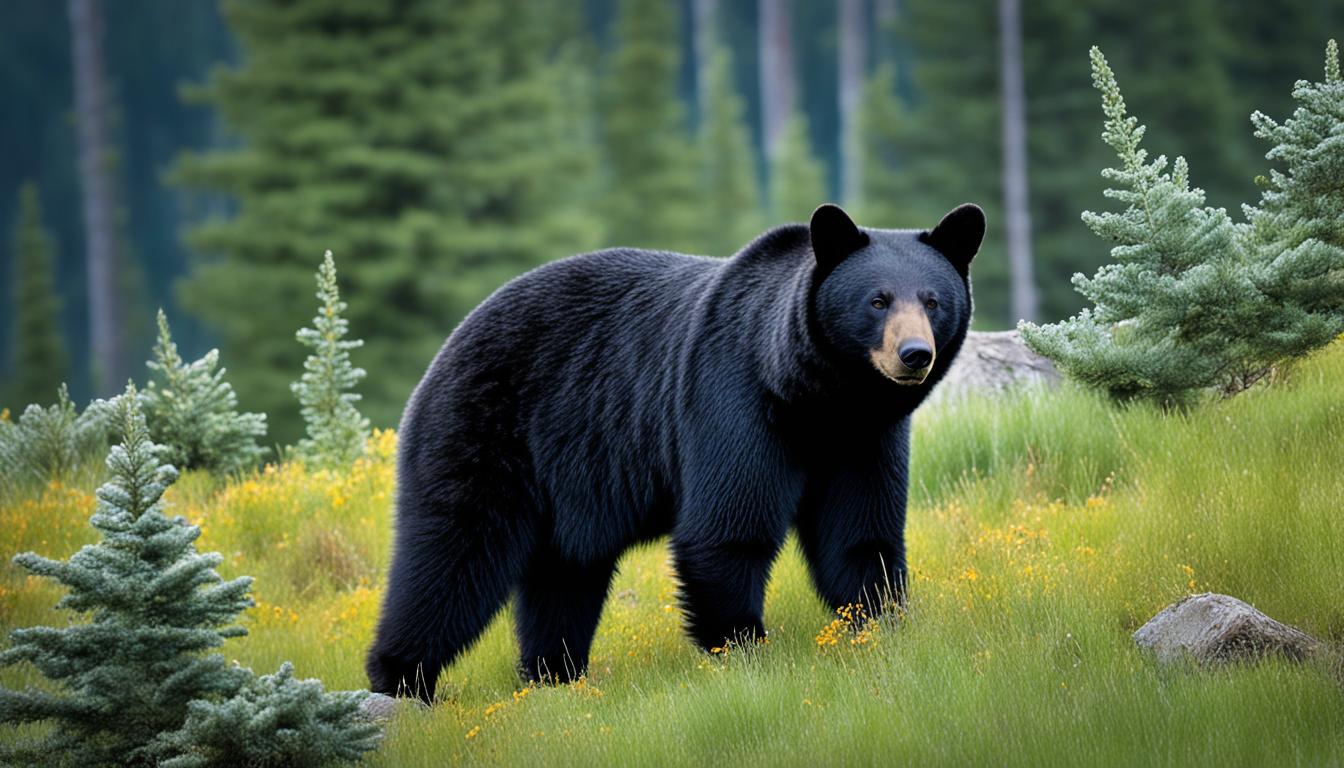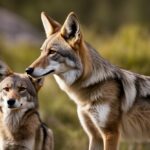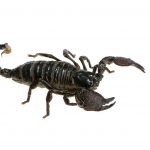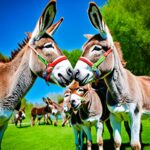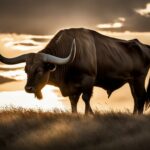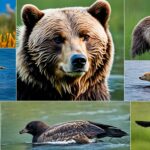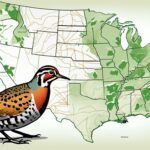The American black bear (Ursus americanus) is known as the smallest bear in North America. Yet, it’s the most diverse in where it lives. This bear evolved separately from the Asian black bear, even though they’re close relatives. Their numbers are more significant than all other bear species combined. They mainly live in forests.
The black bear’s original home covered nearly every forest in North America. This included places like Prince Edward Island, where the last bear was seen in 1937.
Learning about where American black bears live tells us a lot. It shows how well they adjust to different places. These bears do well in large forests and smaller areas too. Their ability to survive in various conditions is impressive.
Introduction to the American black bear
The American black bear is crucial to North America’s wildlife. It shows great ability to live in many places. Its features and how we protect it tell a story of strength and growth.
General characteristics
General characteristics of black bears show they can live in different environments. They eat many things, changing with the seasons. Black bears have many types, each fitting into varied regions of North America.
Black bears stand out because they can live in different spots. From thick forests to marshes, they have found ways to flourish. This ability to live in many places has helped them survive tough times when the environment has changed.
Conservation status
A lot of American black bears means they are not in danger. They are considered a safe species by the IUCN. This is a good sign, especially when many other kinds of bears face difficulties. It shows how well these bears can adjust and keep going.
Knowing about black bears and how we protect them shows their success. It’s good news for their future in the wild.
Historical range of the American black bear
The American black bear has shown it can survive and thrive over thousands of years. Fossils teach us that these bears were all over North America, especially in its forests.
Prehistoric distribution
Around 4.95 million years ago, a bear much like today’s American black bear was roaming. It lived in forests across North America, setting the stage for where black bears live now.
Historical records
For centuries, American black bears have roamed a big part of the continent. They were very good at living in different kinds of forests. This shows they could change and thrive over time.
Current distribution of the American black bear
The American black bear is doing well across North America. It’s important to know where they live now. This helps us see how they’ve learned to thrive in different places.
North America overview
Black bears today are mainly in the large, wooded areas of North America. This includes most Canadian provinces (except Prince Edward Island) down to Mexico. They are also found in many U.S. states. But, their homes are sometimes cut off from each other.
Regional variations
Where the black bears live changes a lot by region. In the east, many are in the Northeast, the Appalachians, and the Southeast coast. These areas show how well the bears can adjust to different habitats.
In the west, they like the big forests and mountains. This shows their strong ability to make a living in various places.
Habitat preferences of American black bears
Seeing the habitat of American black bears is key to knowing how they adapt and survive. These bears love forested regions, especially dense woodlands, swamps, and rough mountains.
Black bears change where they hang out based on the season and what they eat. In spring, they look for new leaves and plants. But by summer, they’re after things like ant pupae and tiny bugs.
In summer, they enjoy berries and fruits, then eat nuts and other rich food in fall before winter snooze time. Their varied diet lets them live in many kinds of places.
Black bears can live in places outside of forests, like swamps or partly open areas. This works if there’s enough food and hiding spots. Their adaptability shows they are tough and resilient.
Knowing where black bears move helps save them. It lets us protect these wild animals so they can keep roaming in North America’s forested regions.
What is the range of the American black bear?
The geographic scope of black bears is wide, spanning across Canada, Alaska, the U.S., and northern Mexico. This shows how well they can adapt.
Geographic scope
American black bears live in many places, from the eastern U.S. forests to the Rocky Mountains. They can also be found in the rich woods of British Columbia and Maine’s quiet forests. They prefer areas where people are few, letting them move around without trouble.
Factors affecting range
Black bears’ homes are shrinking because of cities and agricultural areas. These changes make the bears’ lives harder. They struggle to find food, friends, and places to rest.
Helping with conservation can make a big difference for black bears. Protecting forests and making wildlife areas can keep their homes connected. If people work together, the geographic scope of black bears can be kept or even grown.
| Region | Habitat Characteristics |
|---|---|
| Canada | Dense forests, limited human interaction |
| Alaska | Remote, rugged terrains |
| United States | Varied from Appalachian forests to Rocky Mountains |
| Northern Mexico | Mountainous areas with sparse vegetation |
American black bear population density
The American black bear population varies greatly in number. This change happens because of different local conditions. These key points include available food, habitat quality, and human actions in the area. When there’s a lot of food, bear numbers can go up. This shows how well bears can adapt and how good conservation is working.
| Region | Bear Population Density |
|---|---|
| Eastern United States | High |
| Western United States | Moderate |
| Canada | Variable |
| Mexico | Low |
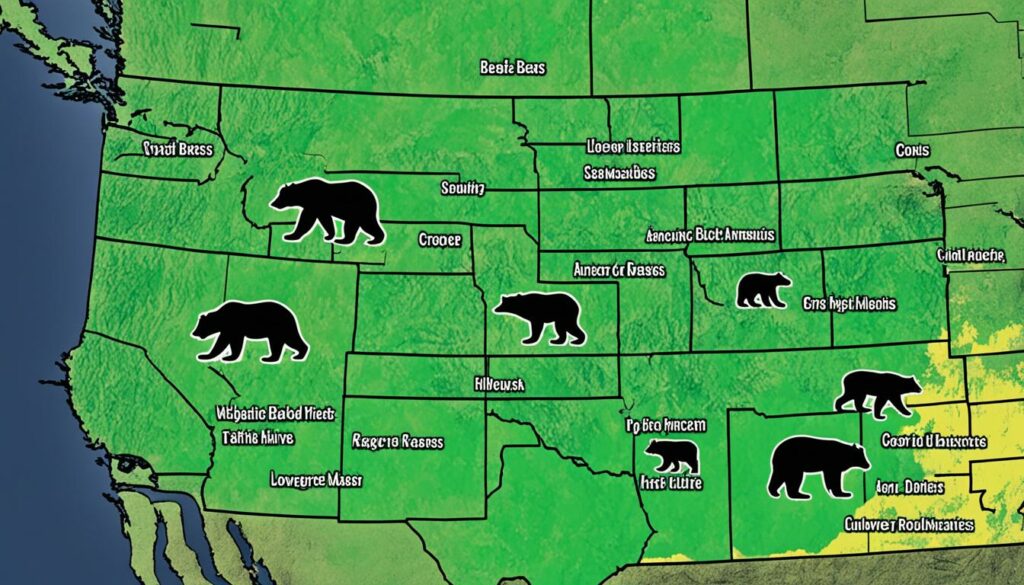
In places where bears find it easier to live, their numbers tend to grow. This is a sign of how strong bears are and how conservation works well. But, when people are around a lot or the environment is damaged, there are fewer bears. This shows how important our actions and the state of the environment are for bears.
Subspecies and their specific ranges
The American black bear has 16 recognized subspecies, showcasing its diverse nature. Each one is specially adapted to its own area, showing how well this species can live in different places.
Recognized subspecies
Knowing the different types of black bear subspecies is key to their protection and research. Each subspecies has unique traits that help them live in their specific homes.
| Subspecies | Geographic Distribution | Key Characteristics |
|---|---|---|
| Ursus americanus altifrontalis | Pacific Northwest, USA | Dense black fur, robust physique |
| Ursus americanus floridanus | Florida, USA | Smaller size, adapted to wetlands |
| Ursus americanus californiensis | California, USA | Distinct brown and black fur |
| Ursus americanus pugnax | Alaska, USA to Canada’s Yukon | Thick, coarse fur |
Geographic distributions
The black bear subspecies can be found all over North America. From the thick forests in the Pacific Northwest to the swamps in Florida, each one has made its home in different environments.
- Olympic black bear: Found in the rainforests of the Pacific Northwest.
- Eastern black bear: Common throughout the Appalachian Mountains.
- Floridian black bear: Prefers the forested wetlands of Florida.
- Southwestern black bear: Inhabits the mountainous regions of New Mexico and Arizona.
The wide range of environments where these bears live shows their ability to adapt. This adaptation helps them survive in various landscapes.
Human impact on American black bear habitat
American black bear habitats are changing a lot because of us. Our cities and towns are spreading into their homes. This makes life hard for black bears. They have to deal with less space to live and find food. The impact of urbanization on black bears is a big deal, along with the cutting down of forests.
Urbanization
More and more people moving to cities is not good news for black bears. It means there’s less forest for them to roam. This loss and breaking up of their homes can force the bears into risky situations with people. These dangerous meetings show how badly urbanization is affecting black bears.
Deforestation
Cutting down trees is also a huge problem for black bears. It takes away the big areas they need to survive. Without enough space, they struggle to eat and find friends. They also have to fight for what they need, which can even lead to more black bears dying. The mix of building over forests and cutting down trees is a big threat. It reminds us we must work hard to keep black bears safe.
“`
Remember to refer to this structured content when writing future sections, ensuring continuity and consistency throughout the article.
Adaptability of the American black bear
The American black bear shows how important adaptability is for survival. It lives in a big, always changing area of North America. By learning how these bears live in different environments, we understand their strength and how they change over time.
Dietary Flexibility
Black bears’ eating habits highlight how flexible they are. They eat both plant and animal food, changing based on what’s available each season. In the spring, they munch on fresh plants. But in summer and fall, they can’t get enough of fruits, nuts, and bugs. Sometimes, they even eat small animals and dead animals. This mix-and-match diet helps them not just survive but do well in places like woods, swamps, mountains, and even near humans.
Behavioral Adaptability
Black bears are also smart about how they act to make it. They have various clever ways of finding food. For example, they climb trees for fruits or break logs for bugs. They also get ready for winter by eating a lot to store fat. This fat keeps them alive while they sleep during the cold months. By studying how bears change what they do during different times, scientists can help them live through changes to their homes and the climate.

